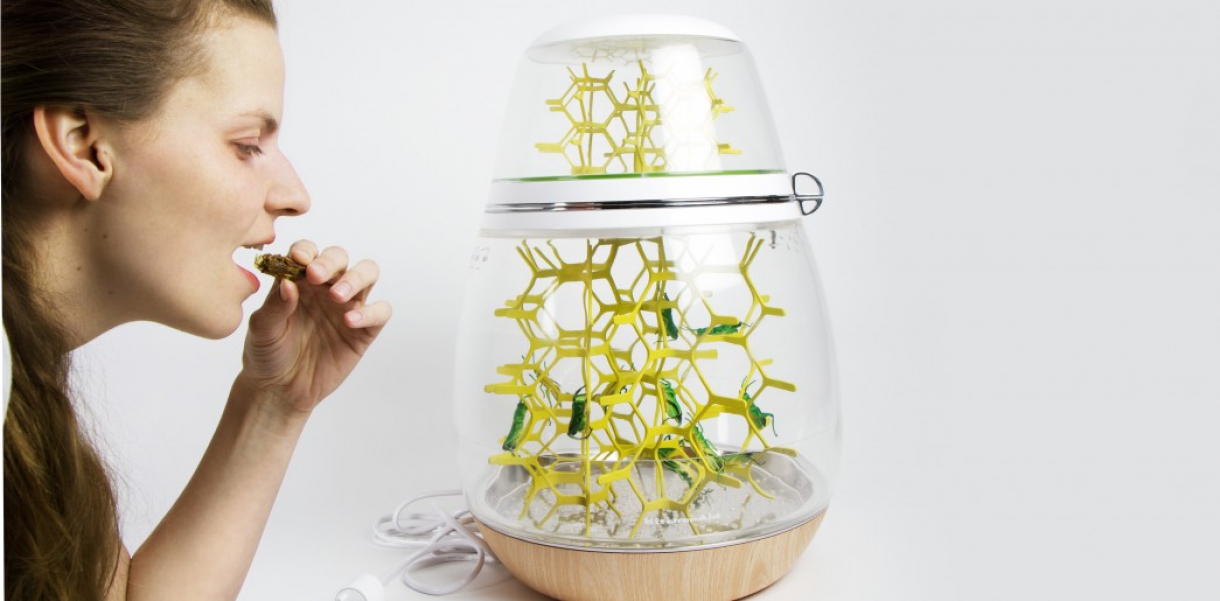Growing and eating nutritious grasshoppers in your kitchen could be a sensible solution to the looming global food shortage predicted for 2050. LEPSIS: The Art of Growing Grasshoppers might sound less than appetizing to some, but the sustainable advantages should be incentive enough for us to rethink what is (in)edible.
"The geopolitics of food is fast overshadowing the geopolitics of oil," said Lester Brown. Arable land-scarcity and our ballooning population are putting acute pressure on food sources. Last year, for the sixth time in eleven years, we consumed more food than we produced. It is too early to tell for 2013, but one thing is for sure: things have to change. It’s no secret that food shortages send food prices spiraling stratospherically; while people in the developed world will just have to get used to extortionate prices, people in developing world will suffer from chronic hunger, if not famine, as food becomes increasingly unaffordable.
“The best way to feed the 9 billion people expected to be alive by 2050 could be to rear billions of common houseflies on a diet of human feces and abattoir blood and grind them up to use as animal feed, a UN report [suggested]” wrote John Vidal. It’s safe to say that this image is making you squirm. Us too, which is why our Jury selected LEPSIS: The Art of Growing Grasshoppers as a finalist, since the beautiful design offers a more palatable option.
Grasshoppers, like houseflies, grow exceptionally fast. Not only are grasshoppers healthier sources of protein, they are environmentally significantly less taxing than other meat production. The problem in introducing, let alone popularizing a diet consisting of grasshoppers has little to do with convincing people of their nutritional value, or the marked environmental benefits – such facts are firmly established – but rather challenging established ideas of what is (in)edible.
Currently eighty grasshopper species are eaten around the world, and form part of the traditional diet for over 2 billion people, meaning delicious grasshopper recipes abound. However, a widespread tendency to think that eating grasshoppers is for primitive folk shrouds the notion of eating grasshoppers in ignorant distaste. Having said that, our very own Copenhagen gem, restaurant Noma (Best Restaurant in the World 2010, 2011, 2012) is making leaps and bounds in popularizing grasshoppers, which form a staple of their haute culinary menu.
Mansour Ourasanah spent the first 16 years of his life in Togo, West Africa. During these years he experienced hunger and poverty due to inflation and droughts, making him develop a profound appreciation for food as an exhaustible food source. In 2001 he moved to New York city, and was confronted by a starkly different food culture and attitude. Food was in abundance, and often wasted. As an industrial designer, he wanted to make a contribution to healthier and more responsible food production and consumption, and so he designed LEPSIS: The Art of Growing Grasshoppers.
Ourasanah teamed-up with KitchenAid to design LEPSIS – an attractive kitchen appliance for breeding grasshoppers domestically. LEPSIS is a vessel optimized for neatly breeding, feeding, harvesting and killing grasshoppers, before turning them into food. Grasshoppers require little room and few resources to grow; they grow to edible maturity in about 1.5 months, and lay plenty of eggs before the die. As for the taste? Well, people are willing to pay hundreds of dollars at Noma for a taste, and that’s saying something.
Naturally, this is not for the faint-hearted. However, it sends an important message: we must reconsider what is (in)edible, and challenge our culturally-bound responses to novel food items. What is noteworthy is that when presented with grasshoppers, children happily play with and eat them. This suggests that our learned disgust is a result of culturally established notions of what to and what not to eat, rather than the taste. 90% of the struggle is forgetting your preconceptions. Like it or not, what we can guarantee is that this design is only the beginning of a new culinary era.






